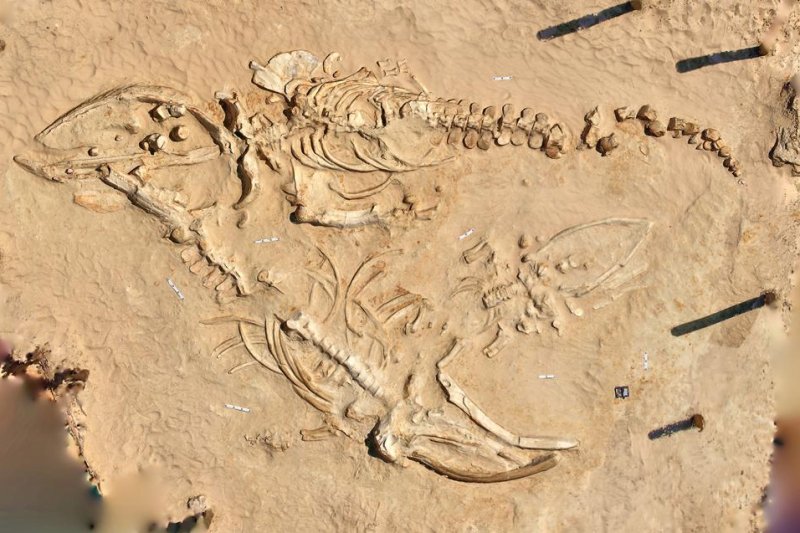Two adult whales and a calf (Nick Pyenson/Smithsonian)
WASHINGTON, Feb. 26 (UPI) -- "We have bones." That's what Chilean construction workers told a local museum they called after stumbling upon several giant fossils while on the northbound lane of the Pan-American Highway in a remote, desert region of northern Chile.
But what archaeologists found was more than just a few bones; they found an aquatic graveyard. A little digging begot an impressive whale skeleton. A little more digging begot more impressive whale skeletons. Before they knew it, archaeologists had unearthed 40 skeletons. The fossils were discovered in four distinct layers of sandstone, spanning 10,000 years of geologic time.
This portion of the Atacama Desert is named Cerro Ballena, Spanish for “Whale Hill,” as the presence of whale fossils there has been known for some time. Never before, however, had scientists discovered such a large concentration of fossils so immaculately preserved.
The fossil treasure trove consisted mostly of the bones of baleen whales, as well a few examples of other strange ocean-dwellers, all washed ashore between six and nine million years ago.
"We found extinct creatures such as walrus whales -- dolphins that evolved a walrus-like face," Nick Pyenson, curator of fossil marine mammals at the Smithsonian’s National Museum of Natural History, told BBC News. "And then there were these bizarre aquatic sloths."
Pyenson lead this remarkable dig in 2010 and 2011, and he and his colleagues have just published a new report in the Royal Society journal that catalogues their findings in splendid detail. In the report, the scientists surmise that the sea mammals likely passed away by consuming toxic algae blooms.
Th report also showcases a new technique Pyenson and his colleagues used to create 3-D models of the buried skeletons.
Because Pan-American Highway had to be paved to facilitate Chile's boombing mining industry, scientists couldn't take their time in studying the fossils as they lay in the ground. They had to be dug up and shipped off, and quickly.
So Pyenson and a "3D-digitisation team" from Smithsonian scanned the skeletons with lasers before they were removed from the earth. Thus, back home in Washington, D.C., the archaeologists were able to recreate detailed virtual models of the ancient whales.
This fall, those models will be used to recreate a giant whale skeleton inside the Smithsonian Institution.
Recreating what they had found would have been near impossible without the new technology. Whales have several hundred bones.
“I don’t wish a whale skeleton on anyone -- it’s a logistical nightmare,” Pyenson told the Washington Post. “It’s a big problem just to excavate one, let alone that number.”
[BBC News]
[Washington Post]















